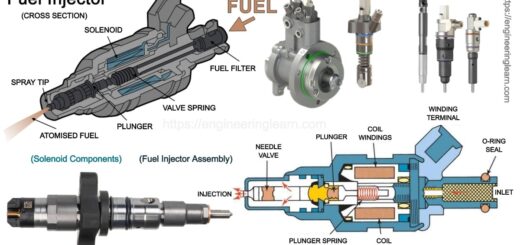11 Parts of Dirt Bike and Their Uses [with Pictures & Names]
![11 Parts of Dirt Bike and Their Uses [with Pictures & Names]](https://engineeringlearn.com/wp-content/uploads/2023/05/Parts-of-Dirt-Bike-1024x539.jpg)
Introduction
Parts of Dirt Bike and Their Uses [with Pictures & Names]: – On the off chance that you end up gazing out the vehicle window at the scene and wandering off in fantasy land about the adrenaline of handling the slopes and patches of dirt, and pulling some sweet dirt bike stunts, then you truly need to get yourself a dirt bike. Dependent upon what state you live in, there are some special tracks and regions where you enjoy dirt bike riding, But you need to keep in mind regarding bounces and hindrances to help with building your riding abilities. As such, it helps with having spare parts considering the way that frequently you have no clue about when parts have reached their limit and without a backup, your riding day ends early which is not expected by you.
What is a Dirt Bike?
Dirt bikes are fun, flexible vehicles that are a phenomenal option in contrast to typical bikes, but numerous individuals have never anytime had a go at riding one. Dirt bikes are a type of non-street-legal bike that need street-safe equipment, as most off-road specific vehicles, and firm suspension to assist you with rising above jumps and travelling through a path with little impact on the spine or bones.
Dirt bikes are bikes explicitly designed for use on dirt, sand, and muddy, gravelly territory. Also buying parts to maintain their dirt bike, numerous riders additionally choose to modify their machines with dirt bike accessories, typically with aftermarket items that are designed to improve the bike’s performance or to change its look in a simple way. They contrast with regular bikes in that their tires and ground clearance are optimized for dirt riding rather than pavement. They are lighter than regular bikes, without fairings or rich additional items, to boost speed and power execution on trails, and have no additional creature comforts like soft seats or passenger backrests.
Parts of Dirt Bike
Dirt bike parts, whether they are execution-oriented or parts to maintain with your dirt bike, are something that each rider will purchase sooner or later. Below we discuss about different parts of Dirt bike: –
- Chassis
- Engine
- Wheels
- Suspension
- Brakes
- Final Drive
- Shock Linkage Bearings
- Crankshaft Bearings
- Valves
- Piston
- Tires
1. Chassis: ( Parts of Dirt Bike )
The chassis is the skeletal structure of a dirt bike. The dirt bike chassis number is most of the time mentioned in the owner’s Manual and registration certificate. At the point when stripped down, motorcycles have an essential frame with a suspension attached. The essential function of the frame is to hold the various parts together in one rigid structure and prevent it from going to pieces. The parts that make up the chassis are the frame the front fork, and the suspension. The dirt bike’s suspension plays a significant role in a rough-riding dirt bike. The rear shocks, under the rider, are attached to the rear axle through the swing arm. The part of the dirt bike that joins or attaches evenly to the rear axle is the swing arm.
2. Engine: ( Parts of Dirt Bike )
Dirt bike engines arrive in a variety of smallest-displacement sizes and in two different engine types (two-stroke engine and four-stroke engine), however, they all offer the way that they are moving a piston up and down in a solitary cylinder to produce power. The two-stroke fires on each rotation or revolution of the crankshaft. This translates to instant power. One of the most important reasons you start modifying your dirt bike because of the reason that not all dirt bike engines from every manufacturer are made equivalent.
Common dirt bike engine modifications include or incorporate a full-race exhaust system, execution air filter, carburetor jetting or EFI tuning, different clutch plates, upgraded camshafts, and big-bore kits that increment the displacement of your engine.
3. Wheels: ( Parts of Dirt Bike )
Dirt bikes have exceptional tires to cope with the bad territory. Tires specially or explicitly designed for hard territory have soft rubber with closely spaced tread blocks. Dirt bike wheels can indeed deal with a limited amount a lot before the spokes start breaking, a section wraps or a section wraps to the rim rendering the bike inoperable. For the best grip sand tires have a widely spaced, paddle tread which makes it convenient for the rider to drive. Intermediate soft/hard tires are likewise accessible within the middle of between the soft and hard types.
4. Suspension: ( Parts of Dirt Bike )
Dirt bike suspension involves an inverted fork that is significantly attached to triple clamps that are further mounted on the steering head on the frame and a shock, which is typically linkage-equipped, and attached to the swing arm and the frame. On the off chance that your bike is older, or on the more affordable side, it could have a right-side fork. The two styles of forks normally feature compression and rebound adjustments, either on one or both fork legs.
Another method if you want to adjust your suspension is to slide the fork tubes up or down in the triple clamps. Spring preload, low-compression, high-speed compression, and rebound are some adjustments related to dirt bike shock. You can work on your suspension and further improve with a budget in mind for setting up your suspension for various obstacles you experience while riding.
5. Brakes: ( Parts of Dirt Bike )
Dirt bikes need good brakes to deal with the trials of motocross and trail riding. Each wheel has separate brakes. These can be drum brakes, where the stopping pressure is applied from inside of the axle, or disc brakes, where a pad is applied to the outside of the brake to slow the bike.
6. Final Drive: ( Parts of Dirt Bike )
The chain, belt, or shaft driven are the final drive systems of a dirt bike. The power is permitted by the chain or shaft which further is transmitted from the gearbox to the wheels which moved the bike. The drive runs from the gearbox back to the rear axle at the end.
7. Shock Linkage Bearings: ( Parts of Dirt Bike )
A dirt bike contains various bearings the majority of which go unnoticed until they come up short. Routine maintenance like cleaning and lubrication extends the existence of bearings definitely more than most different parts aside from the shock linkage bearings. These headings maintain or uphold the reliable motion of the suspension, significantly more prominent load than what steering stem or swing arm bearing handle, and regularly get muddied up with both grime and dirt.
8. Crankshaft Bearings (bottom end): ( Parts of Dirt Bike )
The bottom end of a dirt bike engine includes or incorporates the crankshaft, seals, gaskets, and the one part that fails over all the other things down there – the bearings. In contrast to steering stem or swing-arm bearings, you can only with significant effort clean and lubricate the crankshaft bearings. When they come up short or fail, usually by seizing, it brings about a broken crank/rod.
9. Valves (4-strokes): ( Parts of Dirt Bike )
On the off chance that you don’t keep the valves on your 4-stroke properly adjusted, they will fall flat. Thus lies the problem most riders don’t watch out for the valves whether from neglecting or simply not having any desire to manage them as you need to eliminate a few parts.
All parts in the long run fail however assuming you notice an apparently high rate of occurrence with a particular part or parts, particularly when compared to different riders, twofold check surrounding parts to ensure proper installation, check in with a riding instructor for some extra training or preparation or up your maintenance schedule and check whether that solves the problem.
10. Piston (Top end): ( Parts of Dirt Bike )
The piston is a strong or solid block fixed to a shaft (crank) in a tube (cylinder) and when combustion happens on top of the piston thrusting it in a downward way, and continued the process over and over again. The piston captures and further transfers the energy from combustion on top of the piston in the cylinder into motion at the crankshaft.
11. Tires: ( Parts of Dirt Bike )
Dirt bikes have rubber on the external surface of their tires which improves them to move in a better way in the dirt, unpleasant landscape, mud, and sand, while some other bikes don’t have rubber on the external surface of their tires. This rubber provides a superior grip and balance to dirt bikes, making them efficient for riding on rough roads.
Conclusion
Large numbers of the most skilled motorcyclists initially started by riding dirt bikes. Very few skills are required for riding a dirt bike in a successful way as compared to riding a motorbike, yet the experience will similarly help you with being more confident and comfortable when you’re in the end ready to be out on the road. Riding a dirt bike is a lot more secure than many individuals think. Out on the road, there are numerous obstacles, specifically different vehicles and pedestrians, however, with a dirt bike, which is mainly utilized for off-roading, those obstructions won’t be available.
You may occasionally have somewhat of a wipe-out, as long as you’re consistently wearing all of the essential safety equipment, the odds of suffering a serious injury will be very low. Yet, riding different parts of the country or across the border you generally hear about or that a friend effectively rode, who regularly helps you to remember the significance of the outing, will in general bring back the wonderment of your passion and a desire to accomplish more with your dirt bike.













